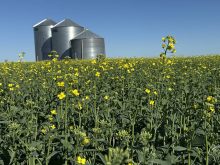Hog producers can look forward to a clear horizon of profitable prices.
“We’re past the danger for several years,” said University of Missouri hog market analyst Ron Plain in an interview.
“We don’t have a whole lot of things to worry about this coming year.”
The four-year hog cycle is operating as it always does, bringing the relief of higher prices following the end-of-cycle price slump. Producers last year reacted as they have always reacted to a poor price outlook, the United States Department of Agriculture found in its Dec. 1 survey of hogs on farms.
Read Also

Huge Black Sea flax crop to provide stiff competition
Russia and Kazakhstan harvested huge flax crops and will be providing stiff competition in China and the EU.
The poor prices in 2002 led to a decline in the number of sows and slaughter hogs on U.S. farms as farmers cut production, the USDA found. Hog slaughter should decline to about 1.8 million head per week, compared to about two million head per week in the latter half of 2002.
The USDA expects overall U.S. meat production to drop by about 1.5 percent in 2003. With the U.S. population expected to increase by about two-thirds of one percent, there will probably be about a two percent drop in the amount of meat produced per capita.
“That’s going to push meat prices higher,” said Plain.
He said retail prices should increase by five or six percent, and because there will be ample slaughter capacity and consumer demand, retailers and packers will probably have to pass most of that increase back to farmers in order to get the pigs.
“With tighter supplies the middlemen are not going to gain much of that runup in retail prices,” said Plain.
“Most of it will be passed through to the producers.”
The Canadian hog market closely follows U.S. prices, and many Manitoba weanlings are sold to American buyers.
But Manitoba Agriculture livestock markets analyst Janet Honey said the Canadian situation is slightly more complicated than in the U.S.
If the Canadian dollar strengthens compared to the U.S. dollar, returns in Canadian dollars will diminish. And if country-of-origin labelling laws make it mandatory to label Canadian pork, prices for Canadian hogs may weaken, Honey said.
But she expects a significant increase in hog prices in 2003. First quarter prices will still be weak as the last of the usual fourth quarter surge of pigs passes through the processing system, but after April, prices are expected to rebound.
Honey expects the average price for an index 100 hog per hundred kilograms of dressed weight, including all premiums and bonuses, to be $140-$150 in the first quarter, rising to $165-$170 in the second, and dropping slightly to $160-$165 in the third quarter and $155-$160 in the fourth quarter, when pig prices are traditionally the lowest of the year. The average price for the year should be $155-$160 per ckg.
Plain expects hog prices to be even better in 2004. That means pig producers have come through the slump, which happens every hog cycle, in better shape than expected. The next couple of years should pay for the losses of 2002.
“As we go forward things will keep getting better,” said Plain.
The fourth quarter of 2002 “wasn’t much fun, and producers lost a fair amount of money, but still it wasn’t a repeat of the fourth quarter of 1998, and it could have been.”

















